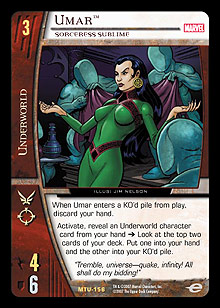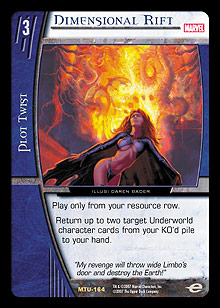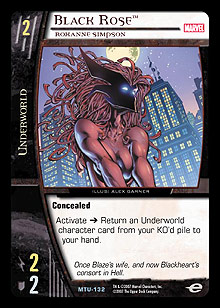Welcome back to Theoretically Speaking. Sorry I have been absent lately; I have undergone many changes in my life, not the least of which was a big move down to Texas (my wife got her dream job). While I have been super busy with non-Vs. related stuff, I have kept my mind racing with ideas to share with you. With City Championships in full swing, I figured now would be a great time to share with you a very basic deck construction tactic that I have often alluded to but never spent the time to explain fully: theme replication.
If you take a look at the decks that are leading the way in the current (and even previous) formats, you can find themes that are being re-used. This is why knowledge of the metagame is such an important tool (and an oft-discussed topic in this column); if you know what is good now and can link it with something that was good before, then you can look at the previous deck’s weaknesses and “replicate” them in the current format.
History Repeating Itself
There is little question that my team and I are huge fans of the Good Guys power-up deck. Whenever we are stumped with deck ideas in any format, if Good Guys is legal, we start looking there. It is curious to me that while we all see the deck as a potential power house, the rest of the “pro” community seems to think that it’s not worth much at all. Ever since its appearance at the Indianapolis Pro Circuit last August, though, the deck has been a mainstay in the competitive Vs. System environment.
So, what made that deck so explosive? What keeps it in the forefront of, at the very least, my mind? Well, it could be that the deck is capable of brickwalling any attack. Or it could be that every card in your hand can be used to further the deck’s goals (via. Shayera Thal ◊ Hawkwoman, Thanagarian Enforcer and Ted Kord ◊ Blue Beetle). Honestly, I think it is both of these qualities that make the deck formidable, and if these qualities can be replicated, then I think the deck’s competitiveness can also be recreated.
Instead of actually building a deck from scratch and going through the deckbuilding process with you, I figured it would be more efficient to list a deck and then discuss how it mirrors the qualities that Good Guys possesses. I’ll also discuss how to identify other qualities in other decks that you may want to recreate.
Identifying Themes
I mentioned a few themes earlier, but there are a variety of others that you may want to consider when looking at a new card pool for inspiration. Below are just a few that I would encourage you to employ:
Failing attacks
Exhausting characters
Focus on power-ups
Focus on low cost characters
Alternative win conditions
One visible character
Recovery effects
Those are just a few themes that have been successful in the past and would be a good starting point when looking into a new or different card pool. I would encourage you to take the below analysis and fine-tune it to whatever theme you are trying to employ. I’m sure you’ll be happy with the results.
The Deck
Characters: 31
3 The Dwarf, Soul Broker
 4 Hellboy, Little Boy
4 Hellboy, Little Boy
4 Black Rose, Roxanne Simpson
3 Abe Sapien, Langdon Everett Caul
4 Umar, Sorceress Sublime
1 Liz Sherman, Pyrokinesis
4 Hellboy, Anung un Rama
3 Abe Sapien, icthyo sapien
1 Dweller-in-Darkness, Fear Lord
1 Madelyne Pryor, Goblyn Queen
3 Hellboy, The Right Hand of Doom
Plot Twists:21
2 Pancakes
3 Ritual Sacrifice
4 Break Off the Horns
4 Death’s Embrace
4 Dimensional Rift
4 Strange Love
Locations:8
2 Surtur’s Anvil
3 B.P.R.D. HQ
3 Soul World
The Inspiration
The deck takes a lot of inspiration from Good Guys, as I first built the deck off the combo of Hellboy, Anung un Rama and Abe Sapien, icthyo sapien. I have mainly been testing for the Modern Age format that will come up at Pro Circuit Indianapolis, and I limited my card pool to those cards that are legal for that event. The concept of being able to power-up out of any attack has always been a staple in the Good Guys deck, so I decided to try to build upon it with this incarnation. These two cards would become the cornerstone of the deck and ultimately lead me the card selection that I chose.
Finding the Scope
When I first stumbled across Abe and Hellboy, I was looking for something very narrow, but by selecting those characters to build upon, my strategy was able to blossom out some. This is true with most decks. You often start with a single, ultimate theme or goal, but as you add cards and characters, you start to see sub-themes develop.
In this deck, Hellboy essentially made the sub-theme easy to establish. It was the same theme that made Hellfire Club so formidable: one visible character. Hellfire, though, had the benefit of several cards that allowed you to move characters back and forth from the visible to the hidden area, so in order to try to utilize that theme, there would need to be some reinvention of how it would be applied in this deck. With Hellboy’s ability being the only source of manipulating your visible and hidden areas, it was obvious that this strategy would live and die by one card. Thankfully, this theme was not the primary one; it would be supplanted by the massive power-up potential that Abe and Hellboy could provide.
The Match Game (Matching Cards with Themes)
Once I established the theme, I needed to find what would actually help me accomplish that goal. I immediately turned my interest to Underworld, as they provided power-up potential in several cards while also fulfilling my need for hidden characters with which to facilitate my sub-theme.
 Concerning the power-up engine that I wanted to focus on, the first card that really caught my eye was Dimensional Rift. This card was brought to my attention because it is, essentially, a recreation of Reconstruction Program, except for the fact that Dimensional Rift is far more balanced. Back in the era of Curve Sentinels, you always had to fear that the deck could power-up out of any attack, and that fear was always predicated on the fact that any power-up in an opponent’s graveyard could also be considered in the opponent’s hand. The drawback that comes with Dimensional Rift can be burdensome, especially if you draw the card in multiples, but it still creates the perception that any two Hellboy character cards in your graveyard could be in your hand.
Concerning the power-up engine that I wanted to focus on, the first card that really caught my eye was Dimensional Rift. This card was brought to my attention because it is, essentially, a recreation of Reconstruction Program, except for the fact that Dimensional Rift is far more balanced. Back in the era of Curve Sentinels, you always had to fear that the deck could power-up out of any attack, and that fear was always predicated on the fact that any power-up in an opponent’s graveyard could also be considered in the opponent’s hand. The drawback that comes with Dimensional Rift can be burdensome, especially if you draw the card in multiples, but it still creates the perception that any two Hellboy character cards in your graveyard could be in your hand.
Surtur’s Anvil is another card that easily fits inside the deck. The biggest issue with this card would be actually having the character cards in the KO’d pile to fuel the activations. This, though, helped lead to other cards that would be included, such as The Dwarf and Umar. The Dwarf would help facilitate the Team-Up while helping get Surtur’s Anvil online, and Umar was the perfect defensive play I was looking for; she allowed me to build up my hand and see a few extra cards each game. Umar’s drawback is not really an issue, as I almost always envisioned bouncing her on turn 4 with Hellboy, Anung un Rama.
Keeping in tune with the KO’d pile manipulation, I decided to include Black Rose, as she would likely be able to stick around for the entire game and could potentially mean failing an attack with power-ups or, at the very least, building my hand advantage by returning several characters.
 At this point, the deck seemed to be coming together quite nicely, with my preferred curve set out something like this:
At this point, the deck seemed to be coming together quite nicely, with my preferred curve set out something like this:
Turn 2: Black Rose
Turn 3: Umar
Turn 4: Hellboy, Anung un Rama
Turn 5: Abe Sapien, icthyo sapien
Of course, everyone knows that while you may have a “preferred” curve, you also almost always have a backup plan in place. Well, considering that Hellboy is the deck, I decided that there would be no need for a backup 4-drop. If I missed him on turn 4, I’d probably lose anyway, so really the best plan was to set up the rest of my curve to make sure that I could use all my resource points.
For a while, I tried out Sydney Leech and Kate Corrigan, but I ultimately settled on Abe Sapien, Langdon Everet Caul. Honestly, this card always jumped out at me for the vibrant colors and the cool picture, but once I included it in the deck, I loved it. If I didn’t hit Black Rose, Abe could provide me with a method of deck thinning that would not only benefit my KO’d pile effects, but would also smooth out my draws. Add in the fact that he is a power-up that can be used for the 5-drop Abe Sapien, icthyo sapien, and I was sold.
The alternate 3-drop that I decided to include was the result of trying tech against other decks that focus on running low-cost characters. Liz Sherman, Pyrokinesis helped facilitate the lone visible character sub-theme while also providing a very beneficial effect, so she was an easy inclusion.
After some consideration, I decided that the deck needed to have some options on turn 6, just in case Hellboy couldn’t finish the job on turns 4 and 5. I couldn’t decide on one character because I wanted both an offensive and a defensive option, so I went with Madelyne Pryor, Goblin Queen for when I had the initiative and Dweller-in-Darkness for when I didn’t. I figured that the control that Dweller would give me on my defensive turns would ensure a stun back, which might be all I’d need to finish the game.
At this point, the character curve was pretty much finished. I just added in several additional copies of the available Hellboy character cards and called it quits.
The plot twist and location selection also seemed to flow seamlessly. As with most decks, I started with relevant search cards. Every deck needs a way to locate its key characters, and as more and more search cards are becoming team stamped, Team-Ups are gaining ground as an important consideration for any deck. So, I started with Ritual Sacrifice (which The Dwarf could search out for me). Instead of completely relying on one team-stamped search card to get the job done, I thought it would be better to hedge my bets and go with two, so I included both Death’s Embrace and B.P.R.D. Headquarters. Both cards would help fill up my KO’d pile while giving me a card I wanted in my hand.
Aside from the search cards, there were other cards that seemed like no-brainers, such as Break Off the Horns and Pancakes, but I ultimately opted to play only a couple Pancakes in favor of the more versatile Strange Love. The ability to recover my lone character, paired with the plethora of power-up cards that I would be packing, made the recovery effects easy inclusions.
One of the last cards that I included was the versatile Soul World, which could help me fill my curve and give me the option of discarding a late drop early only to return it later on. Also, the synergy of paying 4 endurance for a power-up really doesn’t need much explanation.
In the End
Taking a deck and trying to recreate a theme that was successful in another format is always a strong strategy to undertake. Once you have your theme and start finding cards that help facilitate it, you should notice sub-themes starting to develop within your deck. If you try to remain true to those themes and sub-themes, you will definitely be on your way to creating a strong deck that should prove quite competitive.